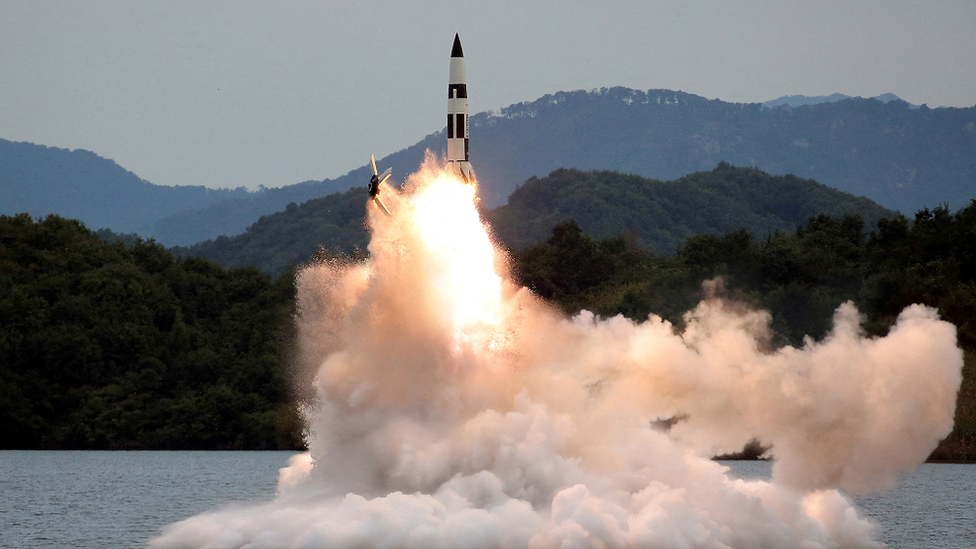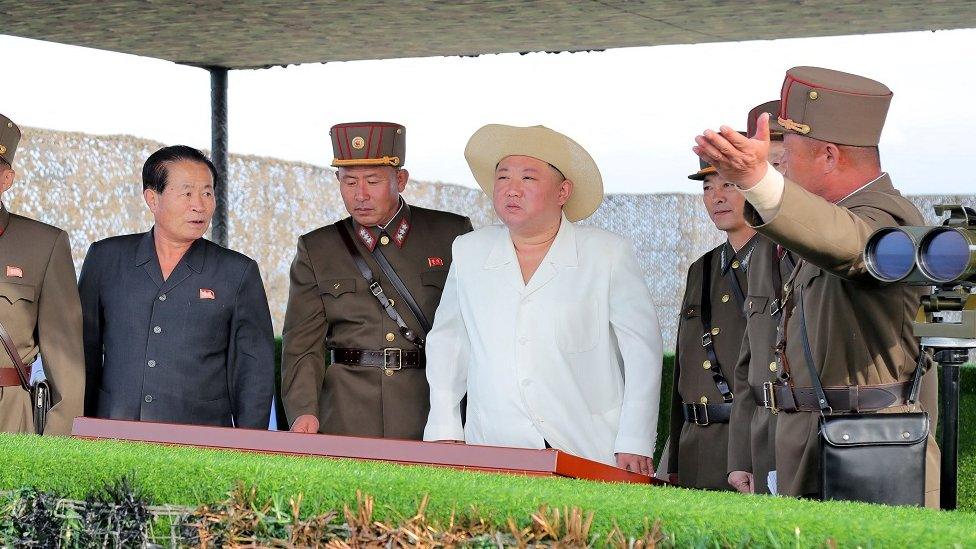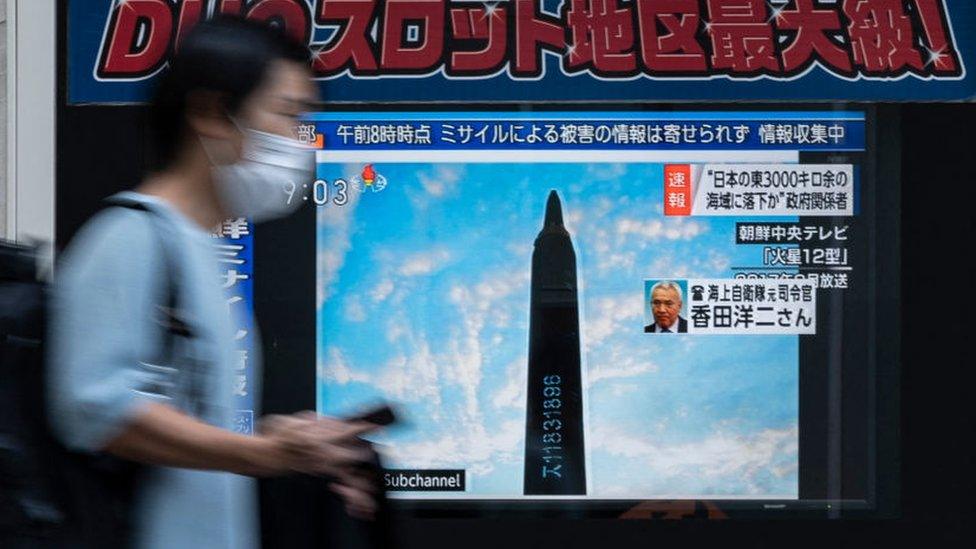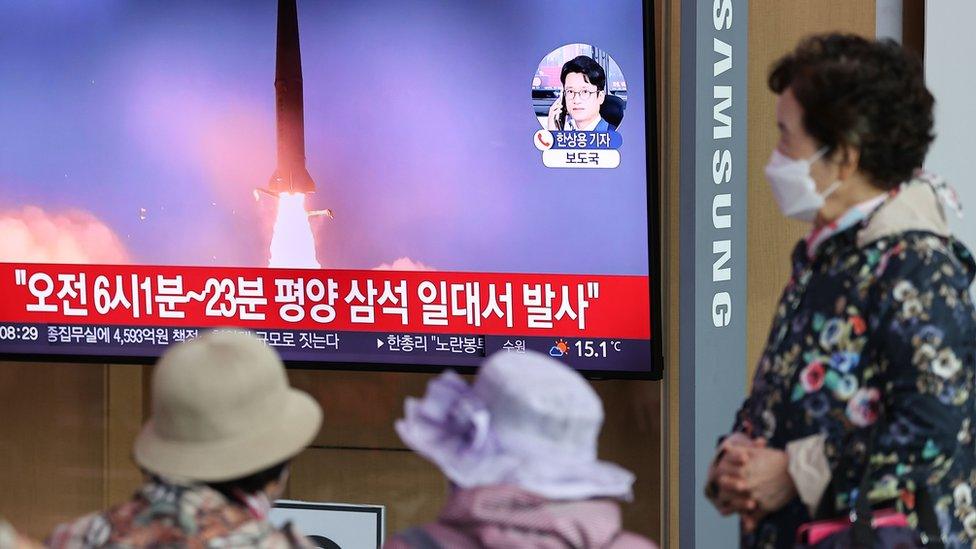North Korea says missile launches were nuclear attack simulation on South
- Published

One of the recent missile launches at an undisclosed area in North Korea
North Korea says its recent barrage of missile launches were a "simulation" of a nuclear attack on the South.
It comes as intelligence suggests North Korea is preparing to hold its first nuclear weapon test in five years.
In recent weeks, Pyongyang has launched seven sets of missiles in response to recent US and South Korea drills.
On Monday, state media published extensive reports claiming the missiles were designed to carry tactical nuclear weapons.
These are small short-range weapons intended for use on the battlefield. They said the military practised loading the missiles with dummy versions of these miniaturised warheads.
They also claimed to have successfully simulated hitting South Korea's military bases, ports and airports, and said the launches were a warning to US and South Korea.
State news agency KNCA ran photos of leader Kim Jong-un overseeing and "guiding" the tests.
South Korean President Yoon Suk-yeol said North Korea has nothing to gain from using nuclear weapons.
"North Korea is advancing its nuclear development and threatening not only the Republic of Korea but the world," he said, referring to South Korea by its official name.
"I believe it has nothing to gain from nuclear weapons."

State media also published several pictures of Kim Jong-un presiding over the missile launches
US and South Korea intelligence officials have been suggesting that the North may soon test a nuclear weapon for the first time since 2017.
Experts believe it could also use the opportunity to detonate a smaller tactical device for the first time - the sort which would fit into the missiles it has been testing.
Last month Kim Jong-un declared North Korea an "irreversible" nuclear power and revised its laws, allowing it to use nuclear weapons pre-emptively. Its previous policy had been to only use such weapons in response to an attack.
It has also markedly stepped up its frequency of missile firings this year, carrying out over 40 missile launches this year so far - its most ever.
Most of the launches in the past fortnight have been short-range missiles, which landed in the sea between North Korea and Japan.
But North Korea also fired a longer-distance missile over Japan last Tuesday - which analysts say is a new intermediate-range ballistic missile, based on the weapon's design.
This year has seen the North test-fire missiles from a variety of launch sites including trains and convoys - moving platforms which would make it harder for the weapons to be destroyed in a strike, analysts have suggested.
They also noted that Monday's state media reports framed the recent launches as "tactical nuclear operations units" - instead of describing them purely as missile tests - suggesting that North Korea has now developed a system for deploying smaller, short-range nuclear weapons.
The 25 September-October 9 barrage were a response to the US deploying its nuclear-powered aircraft carrier the USS Ronald Reagan to waters around the Korean peninsula, and holding joint drills with Seoul and Tokyo.
The acceleration marks a significant change from when Pyongyang pursued denuclearisation talks with then US President Donald Trump between 2018 and 2019.
Analysts say North Korea is also reacting in response to South Korea's President Yoon Suk-yeol, who was elected in May and has pursued a more hawkish stance to the North and closer ties with the US.
North Korea's recent launches
Sunday 25 September: A short-range missile fired the day after a US naval carrier arrived in waters around the Korean peninsula. 600km distance/60km altitude
Wednesday 28 September: Two short-range missiles fired on the eve of US Vice President Kamala Harris' visit to Seoul and the DMZ. 360km distance/30km altitude
Thursday 29 September: Two short-range missiles after Harris departed South Korea. 300km distance/50km altitude
Saturday 1 October: Two short-range missiles fired amid continuing US-South Korea-Japan drills. 400km distance/50km altitude
Tuesday 4 October: An intermediate-range ballistic missile fired over Japan. 4,500km distance/1,000km altitude
Thursday 6 October: Two short-range missiles fired. 800km distance/50km altitude
Sunday 9 October: Two more short-range missiles
Related topics
- Published4 October 2022

- Published29 September 2022

- Published6 October 2022
